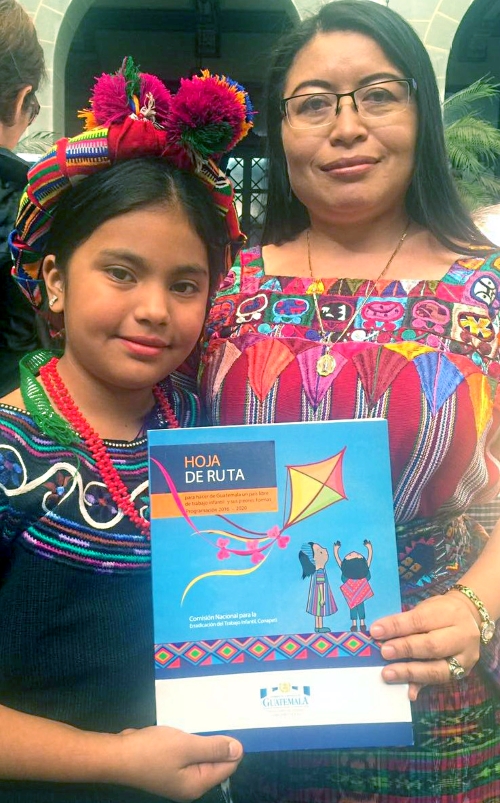
Guatemala considers a route to become a country free of child labor
31 de January de 2017
Share
The Government officially presented the 2016-2020 Roadmap, drawn up in a tripartite manner.
Government authorities presented, on January 26, the 2016-2020 Roadmap to make Guatemala a country free of child labor and its worst forms.
The Programming that constitutes this sheet was developed with the support of the ILO and is the product of an evaluation process of previous national strategies and participatory workshops for the construction of the process, in which the members of the National Tripartite Committee for the Eradication of Child Labor participated. , CONAPETI, and the Departmental Committees, as well as civil society organizations.
Guatemala is one of the countries in this region with the highest rate of child labor. Although this country is showing progress to address this problem, the vulnerabilities that affect children and adolescents place them at risk or in a situation of child labor.
In particular, the problem affects children who come from indigenous communities, children who grow up in rural or agricultural contexts, who do not study, or whose education options are scarce or of low quality. Hence, the formulation of the Programming of the Roadmap 2016-2020 presented, takes into account the specific needs of these populations that are in a greater situation of vulnerability.
The 2016-2020 Programming of the Roadmap to make Guatemala a country free of child labor and its worst forms, was officially presented by President Jimmy Morales, in an act that took place in the National Palace on January 26, 2017 The event was attended by officials from the different branches of government, representatives of the employer and worker sectors, among other guests.
The Roadmap presented is made up of 6 dimensions called: 1) Fight against poverty, 2) Health policy, 3) Educational policy, 4) Regulatory framework and comprehensive protection, 5) Awareness and citizen participation and 6) Generation of knowledge and monitoring.

Towards the goal 8.7
It is expected that the effective implementation of this Roadmap, with the appropriate allocation of funds, will contribute not only to the acceleration of the reduction of child labor in Guatemala, but also to reduce the indicator for the region as a whole; an objective to which Guatemala has committed itself as a founding country and an active member of the Regional Initiative for Latin America and the Caribbean free of child labor *. This commitment is reinforced in the spirit of goal 8.7 of the 2030 Agenda, which proposes the eradication of child labor in 2025.
The foregoing, bearing in mind that child labor and its worst forms are a violation of the human rights of every child and adolescent, a problem that shows how poverty, exclusion and inequality impede human development, economic well-being and Social.
Agriculture, vast field of child labor
According to the general data reported for Guatemala in the 2014 National Survey of Living Conditions (Encovi), there are 790,243 employed children, of which 450,439 are engaged in agriculture or related activities. Manufacturing is the second branch of activity. The situation is mainly located in the rural area in the southwestern and northwestern regions, which concentrate indigenous population dedicated to agriculture.
* The Regional Initiative Latin America and the Caribbean free of child labor is a cooperation instrument made up of 27 countries in the region, with active participation of employers 'and workers' organizations, which arises with the purpose of accelerating the progress of Latin America and the Caribbean in the elimination of child labor, complementing national agendas. The Regional Initiative represents the commitment of the countries and a commitment to joint effort and mutual support, as decisive factors to make the eradication of child labor an achievable goal. For more information, enter here .
Comments
.jpeg)
Sumando esfuerzos para que América Latina y el Caribe sea una región libre de tr...
21 de June de 2024
En conmemoración del X aniversario de la Iniciativa Regional y el 25 aniversario del Convenio 182 de la OIT, se llevó a cabo un seminario de dos días...

Una década de lucha contra el trabajo infantil: Países de América Latina y el Ca...
12 de June de 2024
la Iniciativa Regional cumple 10 años de trayectoria, y para iniciar la conmemoración de este X Aniversario, sus integrantes han co-creado un mural e...
.png)
Barbados reafirma su compromiso tripartito para la erradicación del Trabajo Infa...
25 de April de 2024
El desarrollo de acciones de prevención y erradicación del trabajo infantil es una prioridad para el gobierno, organizaciones de empleadores y de trab...
.png)
The Regional Initiative for Latin America and the Caribbean Free of Child Labour...
01 de April de 2024
The Regional Initiative Latin America and the Caribbean Free of Child Labour deeply regrets the passing of Rumiko Tanaka, who, from the labour sector,...

Red de Puntos focales reafirma compromiso para impulsar la erradicación del trab...
07 de February de 2024
Los Puntos Focales de la Iniciativa Regional América Latina y el Caribe Libre de Trabajo Infantil, se ratificó el compromiso de acelerar las acciones...
